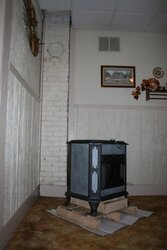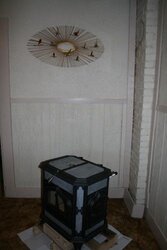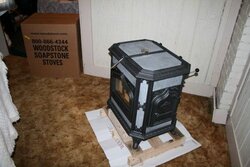We ordered a new Woodstock Fireview at the end of Sept. It arrived last week. Me and my brother worked like a two man Ox Team to get it off my pickup and into the house, it was a difficult task.
I have been reading here of the Pros and Cons of various hearth pad designs. Ours will be a corner install into a partially exposed brick chimney (see attached pic of approx final destination).
The wife and I have been viewing pics of various installs and are leaning toward an elevated hearth pad. We are considering installing some heavy duty drawers in the hearth platform for kindling and misc stove stuff that normally clutters the stove area. I haven't found a pic of such an install, but there must be some out there among the lurkers here. This could be a lower 2 x 12 structure with Framing located to accomodate the drawer locations and widths, topped with a 2x4 deck spaced 12 or 16" on center to support the 3/4" plywood, 24 ga sheet metal if I can locate some, and 1/2" Wonderboard with a tile surface.
I am also considering modifying the chimney to lower the thimble entry into the chimney. This would allow for a straight rear exit into the chimney sort of like a fireplace hearth install and allow a more usefull Mantle shelf without a stove pipe running in front of it. My wife will undoubtedly want to sit those little "fire starters" known as Longaberger Baskets on the shelf. The chimney seems to have a large approx 2" limestone gravel filling the cavity below the current thimble. This could be as simple as removing a few bricks and mining out the "gravel" between the existing bottom and the new lower opening. If it changes to mortar or concrete filling, I guess I close it up and use the current thimble with a few more elbows and interior stove pipe, likely no mantle shelf. I know stove pipe radiates heat almost as good as the stove, but I think we'll have a little heat to sacrifice to make the planned mantle shelf a little more user friendly.
Obviously I only want to install a new chimney liner once, so if I am going to (attempt) lower it, now is the time. Part of me wants to slap up a simple temporary "starter" hearth pad, worry about a more elaborate tall hearth platform later. Right now I'm leaning toward a compromise of sorts, a 2 x 4 platform with a best guess as to new thimble connection height suitable for the final design, use a few more elbows to connect it now (knowing once we are up and running I am less likely to ever change it). FYI house is an old 100 + years sort of Cape Cod farmhouse at about 1500+ SF about 900 roughly 4 square partially open floorplan with mud room addition on far end from hearth room, sort of central stairway with 1 bedroom each side of landing at about 500 SF. We have an interior chimney with a minimum of 21 feet to existing thimble, possibly 25', to be propperly lined with a new insulated 6" liner either way. Based on recent draft observations from top of completely open chimney I should have a decent, possibly good draft (It sucks enough heated air from the house I think I could sit a lawn chair on top and wait for Santa on Christmas Eve in a tee shirt)
I know based on that brief (ha ha) narrative there are about 10 directions this thread could take, but I tried to provide enough info to save some time answering the unavoidable barrage of obvious questions that seem to initiate such a discussion thread. I'll try to limit my expected answers to just a few questions . . .
1. 16" tall hearth platform . . . . good or bad?
2. eliminating 3 to 4 feet of interior stove pipe and a few elbows . . . . . good or bad?
a few pics attached . .
I have been reading here of the Pros and Cons of various hearth pad designs. Ours will be a corner install into a partially exposed brick chimney (see attached pic of approx final destination).
The wife and I have been viewing pics of various installs and are leaning toward an elevated hearth pad. We are considering installing some heavy duty drawers in the hearth platform for kindling and misc stove stuff that normally clutters the stove area. I haven't found a pic of such an install, but there must be some out there among the lurkers here. This could be a lower 2 x 12 structure with Framing located to accomodate the drawer locations and widths, topped with a 2x4 deck spaced 12 or 16" on center to support the 3/4" plywood, 24 ga sheet metal if I can locate some, and 1/2" Wonderboard with a tile surface.
I am also considering modifying the chimney to lower the thimble entry into the chimney. This would allow for a straight rear exit into the chimney sort of like a fireplace hearth install and allow a more usefull Mantle shelf without a stove pipe running in front of it. My wife will undoubtedly want to sit those little "fire starters" known as Longaberger Baskets on the shelf. The chimney seems to have a large approx 2" limestone gravel filling the cavity below the current thimble. This could be as simple as removing a few bricks and mining out the "gravel" between the existing bottom and the new lower opening. If it changes to mortar or concrete filling, I guess I close it up and use the current thimble with a few more elbows and interior stove pipe, likely no mantle shelf. I know stove pipe radiates heat almost as good as the stove, but I think we'll have a little heat to sacrifice to make the planned mantle shelf a little more user friendly.
Obviously I only want to install a new chimney liner once, so if I am going to (attempt) lower it, now is the time. Part of me wants to slap up a simple temporary "starter" hearth pad, worry about a more elaborate tall hearth platform later. Right now I'm leaning toward a compromise of sorts, a 2 x 4 platform with a best guess as to new thimble connection height suitable for the final design, use a few more elbows to connect it now (knowing once we are up and running I am less likely to ever change it). FYI house is an old 100 + years sort of Cape Cod farmhouse at about 1500+ SF about 900 roughly 4 square partially open floorplan with mud room addition on far end from hearth room, sort of central stairway with 1 bedroom each side of landing at about 500 SF. We have an interior chimney with a minimum of 21 feet to existing thimble, possibly 25', to be propperly lined with a new insulated 6" liner either way. Based on recent draft observations from top of completely open chimney I should have a decent, possibly good draft (It sucks enough heated air from the house I think I could sit a lawn chair on top and wait for Santa on Christmas Eve in a tee shirt)
I know based on that brief (ha ha) narrative there are about 10 directions this thread could take, but I tried to provide enough info to save some time answering the unavoidable barrage of obvious questions that seem to initiate such a discussion thread. I'll try to limit my expected answers to just a few questions . . .
1. 16" tall hearth platform . . . . good or bad?
2. eliminating 3 to 4 feet of interior stove pipe and a few elbows . . . . . good or bad?
a few pics attached . .




